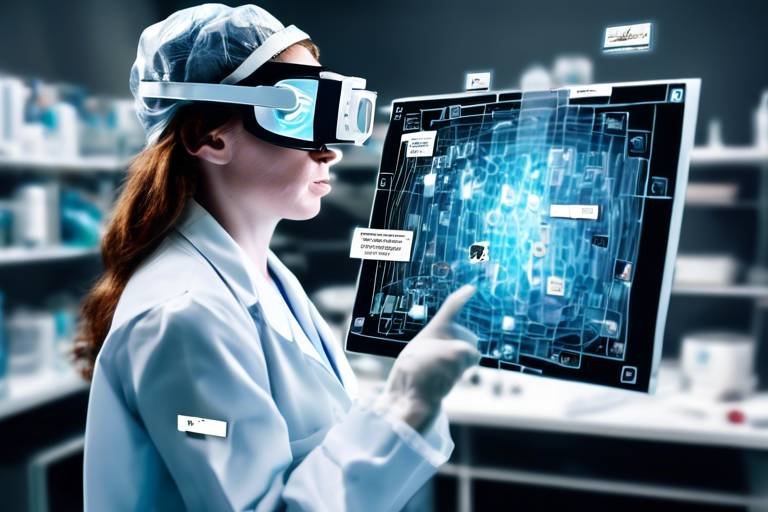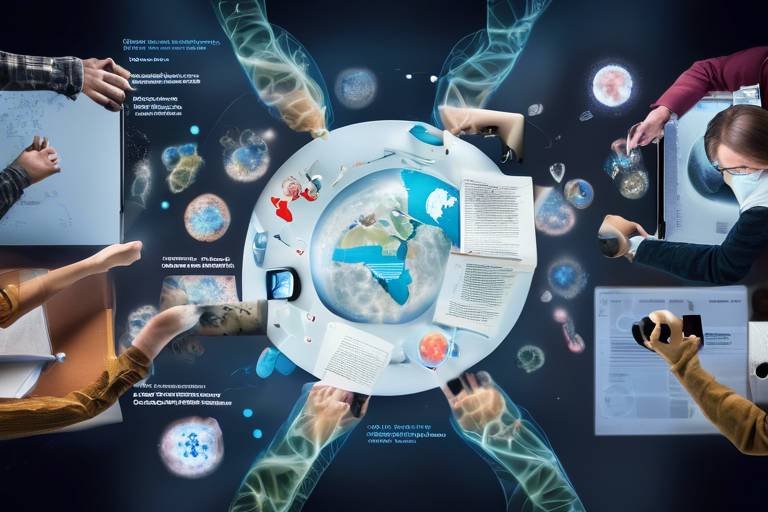The Future of Interactive Technology in Science Education
The landscape of education is rapidly evolving, and at the forefront of this transformation is interactive technology. As we delve into the future of science education, it becomes increasingly clear that technology is not just a tool, but a vital partner in the learning process. Imagine a classroom where students can explore the depths of the ocean or the vastness of space without ever leaving their seats. This is the promise of interactive technology, which is reshaping how students engage with scientific concepts. By creating immersive and engaging learning experiences, technology enables students to grasp complex ideas in a way that traditional methods simply cannot achieve.
In this brave new world of education, the role of teachers also evolves. They become facilitators of knowledge, guiding students through a rich tapestry of digital resources and interactive tools. With the help of technologies like virtual reality (VR), augmented reality (AR), and artificial intelligence (AI), educators can create lessons that not only inform but also inspire. These tools allow for a more personalized learning experience, catering to the unique needs of each student. The future of science education is not just about memorizing facts; it's about fostering curiosity and encouraging exploration.
As we look ahead, the integration of interactive technology in science education presents a myriad of opportunities. From virtual labs that allow students to conduct experiments in a safe, controlled environment to AI-driven platforms that adapt to individual learning styles, the possibilities are endless. However, with these advancements come challenges that must be addressed. Ensuring that all students have access to these technologies, providing adequate training for educators, and securing the necessary funding are just a few of the hurdles we must overcome.
Ultimately, the future of interactive technology in science education is bright and full of potential. As we embrace these innovations, we must remain committed to creating equitable learning environments that empower all students to thrive. The journey towards a more interactive, engaging, and effective science education is just beginning, and it's one that we should all be excited to embark upon.
- What are some examples of interactive technology in science education? Interactive technologies include virtual reality simulations, augmented reality applications, and AI-powered learning platforms that adapt to student needs.
- How does interactive technology enhance student engagement? By providing immersive experiences and gamified learning scenarios, interactive technology captures students' attention and motivates them to explore scientific topics more deeply.
- What challenges does interactive technology face in education? Challenges include limited funding for schools, the need for teacher training, and ensuring equitable access to technology for all students.

Emerging Technologies in Education
Innovative technologies such as virtual reality (VR), augmented reality (AR), and artificial intelligence (AI) are revolutionizing the landscape of science education. These tools are not just fancy gadgets; they are gateways to immersive learning experiences that engage students on a whole new level. Imagine stepping inside a cell to explore its intricate structures or using AR to visualize complex chemical reactions right in your classroom. This is not science fiction—it's happening now!
Virtual reality allows students to experience scientific phenomena in a simulated environment. For instance, VR can transport students to the depths of the ocean or even to outer space, giving them a firsthand look at ecosystems and celestial bodies. This kind of engagement can spark curiosity and inspire a love for science that textbooks simply cannot achieve. On the other hand, augmented reality enhances the real world with digital overlays, making learning interactive and visually stimulating. Students can point their devices at a diagram and see a 3D model come to life, transforming abstract concepts into tangible experiences.
Meanwhile, artificial intelligence is paving the way for personalized learning experiences. AI can analyze a student's performance in real-time and adapt the curriculum to meet their individual needs. This means that students who may struggle with certain concepts can receive tailored resources and support, while those who excel can be challenged further. The potential for AI in education is vast, and it promises to create more inclusive and effective learning environments.
In summary, the integration of VR, AR, and AI into science education is not merely a trend; it is a fundamental shift in how we approach teaching and learning. These technologies foster a deeper understanding of scientific principles, making education more engaging and accessible. As we look to the future, the question remains: how can educators effectively harness these tools to maximize their impact? The answer lies in thoughtful integration, ongoing professional development, and a commitment to ensuring that all students have access to these transformative technologies.

Benefits of Interactive Learning
Interactive learning is not just a buzzword; it’s a revolutionary approach that is reshaping the landscape of science education. Imagine stepping into a classroom where students are not just passive recipients of information but active participants in their learning journey. This dynamic environment fosters greater student engagement, boosts retention rates, and encourages collaboration among peers. The result? A more vibrant and effective educational experience that prepares students to tackle future challenges head-on.
One of the most significant advantages of interactive learning is its ability to capture students' attention. Traditional methods may leave students feeling like they’re just going through the motions, but interactive technologies breathe life into the curriculum. With tools like virtual reality (VR) and augmented reality (AR), students can immerse themselves in scientific concepts, exploring everything from the human body to distant galaxies. This engagement not only makes learning enjoyable but also ignites a deeper interest in science. After all, who wouldn’t be fascinated by the chance to walk on Mars or dissect a virtual frog?
When students are engaged, they’re more likely to invest time and effort into their studies. Interactive learning environments encourage exploration and inquiry, prompting students to ask questions and seek answers. This hands-on approach transforms learning into an adventure. For instance, students might use simulations to conduct experiments that would be too dangerous or impractical in a traditional lab setting. This kind of experiential learning not only solidifies their understanding but also makes them more curious about the world around them.
Another exciting facet of interactive learning is gamification. By incorporating game elements into science education, teachers can enhance motivation and participation. Consider a scenario where students earn points for completing challenges or unlocking achievements as they master complex topics. This setup not only makes learning fun but also encourages healthy competition among peers. It’s like turning the classroom into a science-themed video game, where students are the heroes of their own educational quests!
Moreover, interactive technology fosters collaborative learning environments. Students can work together on projects and experiments, sharing ideas and resources. This teamwork builds a sense of community, allowing students to learn from one another. When they collaborate on solving real-world scientific problems, they develop essential skills like communication and critical thinking. It’s a win-win situation where everyone benefits from shared knowledge and diverse perspectives.
Interactive technology also plays a crucial role in making science education more accessible to diverse learners. Students with disabilities, for instance, can benefit from adaptive tools and resources tailored to their individual needs. This inclusivity ensures that everyone has the opportunity to engage with science, regardless of their background or learning style. By breaking down barriers, interactive learning paves the way for a more equitable educational landscape.
In summary, the benefits of interactive learning in science education are profound. By increasing engagement, incorporating gamification, promoting collaboration, and enhancing accessibility, interactive technologies are not just tools; they are gateways to a richer, more dynamic learning experience. As we look to the future, it’s clear that embracing these innovative approaches will be essential in preparing students for the challenges of tomorrow.
- What is interactive learning?
Interactive learning is an educational approach that actively engages students in the learning process, often through technology and collaborative activities. - How does interactive technology enhance science education?
It provides immersive experiences that help students understand complex concepts, increases engagement, and promotes collaboration. - What are some examples of interactive technologies?
Examples include virtual reality (VR), augmented reality (AR), simulations, and gamified learning platforms. - Can interactive learning accommodate diverse learners?
Yes, interactive technology can be tailored to meet the needs of students with various learning styles and disabilities.

Increased Engagement
Interactive technologies are revolutionizing the way students engage with science education. Imagine stepping into a world where learning feels less like a chore and more like an exciting adventure. With tools like virtual reality (VR) and augmented reality (AR), students can explore the intricate details of the human body or dive deep into the ocean without ever leaving their classrooms. This immersive experience captures their attention and ignites a thirst for knowledge that traditional methods often struggle to achieve.
When students are actively involved in their learning process, they are more likely to retain information and develop a genuine interest in scientific concepts. For instance, rather than simply reading about the solar system in a textbook, students can use AR apps that allow them to visualize planets orbiting around the sun right in their classroom. This hands-on approach not only makes learning fun but also helps to solidify complex ideas in their minds.
Moreover, interactive technologies can cater to various learning styles, making it possible for students to engage with material that resonates with them. Some may benefit from visual aids, while others might find auditory explanations more effective. By incorporating a variety of interactive elements, educators can create a customized learning experience that addresses the unique needs of each student. This adaptability is crucial in a diverse classroom where one size does not fit all.
Additionally, the integration of gamification into science education has proven to be a game changer. By incorporating game mechanics such as points, levels, and challenges, students are motivated to participate more actively in their learning. For example, they might earn rewards for completing experiments or solving scientific puzzles, which encourages them to push their boundaries and explore topics in greater depth. This element of competition can be particularly engaging, as students strive to outperform their peers while still collaborating in a shared learning environment.
Ultimately, the goal of increasing engagement through interactive technology is not just to make learning enjoyable but to foster a deeper understanding of scientific principles. As students become more engaged, they are more likely to ask questions, seek out additional resources, and develop critical thinking skills that will serve them well beyond the classroom. The future of science education is bright, and with the right tools, we can empower the next generation of scientists to explore, discover, and innovate.
- What types of interactive technologies are commonly used in science education?
Common technologies include virtual reality, augmented reality, simulations, and gamified learning platforms that make complex scientific concepts more accessible and engaging. - How does interactive technology improve student engagement?
By providing immersive and hands-on experiences, interactive technologies capture students' attention and motivate them to explore subjects more deeply, leading to better retention and understanding. - Are there any challenges in implementing interactive technology in classrooms?
Yes, challenges include funding limitations, the need for teacher training, and ensuring equitable access to technology for all students. - Can interactive technology cater to different learning styles?
Absolutely! Interactive technologies can be designed to support various learning styles, allowing students to engage with content in ways that resonate with them personally.

Gamification in Learning
Gamification in learning is like adding a sprinkle of magic to the educational experience, transforming mundane lessons into thrilling adventures. Imagine walking into a classroom where the atmosphere buzzes with excitement, where students are not just passive recipients of information but active participants in their learning journey. By incorporating game elements into science education, educators can ignite a spark of curiosity and motivation that traditional methods often fail to achieve. But how does this work? It’s all about creating an engaging environment where students feel challenged yet supported, turning learning into a game where they can earn points, unlock achievements, and even compete with their peers in a friendly manner.
One of the key aspects of gamification is the use of challenges and rewards. Students can tackle scientific problems through interactive scenarios that simulate real-world situations. For instance, a chemistry class might turn into a quest where students must "solve" a series of chemical reactions to progress to the next level. This approach not only makes learning fun but also deepens understanding as students actively apply concepts rather than just memorizing them. Think of it as a video game: the more you play, the better you get, and each level mastered brings a sense of accomplishment that fuels further exploration.
Moreover, gamification fosters a collaborative learning environment. Students can work together in teams to complete missions, share strategies, and celebrate victories. This collaboration mimics real-life scientific endeavors where teamwork is essential. By encouraging students to communicate and collaborate, gamification helps build essential skills such as problem-solving, critical thinking, and interpersonal communication. It’s like being part of a scientific community where each member contributes to the collective goal, making the learning experience more enriching and memorable.
In addition, gamification can be tailored to meet diverse learning needs. Adaptive technologies can track student progress and adjust challenges accordingly, ensuring that every learner is engaged at their level. This means that whether a student is struggling or excelling, the gamified experience can be customized to keep them motivated. Ultimately, by integrating gamification into science education, we not only make learning more enjoyable but also equip students with the skills they need to thrive in an ever-evolving world.
- What is gamification in education? Gamification in education involves using game-like elements in learning to enhance student engagement and motivation.
- How does gamification improve learning outcomes? By making learning interactive and enjoyable, gamification increases student participation and retention of information.
- Can gamification be applied to all subjects? Yes, while it is particularly effective in subjects like science, gamification can be adapted for various disciplines, including math, history, and language arts.
- What are some examples of gamification in science education? Examples include interactive simulations, educational games, and project-based learning that incorporates competitive elements.

Collaborative Learning Environments
In today's rapidly evolving educational landscape, are becoming essential for effective science education. These environments leverage interactive technology to create spaces where students can work together, share ideas, and engage in hands-on learning experiences. Imagine a classroom buzzing with energy, where students huddle around digital simulations, discussing their findings and brainstorming solutions to complex scientific problems. This dynamic setting not only enhances understanding but also cultivates essential skills such as teamwork, communication, and critical thinking.
The integration of technology into collaborative learning fosters a sense of community among students. For instance, platforms like virtual labs and interactive whiteboards allow students to collaborate in real time, regardless of their physical location. This is particularly beneficial in a world where remote learning is becoming more common. Students can work on projects together, conduct virtual experiments, and even present their findings to classmates, all while developing a deeper understanding of scientific concepts.
Moreover, collaborative learning environments can be tailored to accommodate diverse learning styles and needs. For example, students who may struggle with traditional methods can benefit from group activities that utilize technology, such as simulation games or interactive quizzes. These tools not only engage students but also provide immediate feedback, allowing them to learn from mistakes and improve their understanding in a supportive setting. As a result, students feel more confident and empowered to explore scientific topics.
To illustrate this point, consider the following benefits of collaborative learning environments:
- Enhanced Problem-Solving Skills: Working in groups encourages students to tackle real-world problems collaboratively, fostering creativity and innovation.
- Peer-to-Peer Learning: Students can learn from each other’s strengths, gaining new perspectives that enrich their educational experience.
- Increased Motivation: The social aspect of collaboration can motivate students to participate more actively, making learning a fun and engaging process.
In summary, collaborative learning environments powered by interactive technology not only make science education more engaging but also prepare students for the collaborative nature of the modern workplace. By fostering teamwork and communication, these environments create a holistic educational experience that equips students with the skills they need to thrive in their future careers.
- What are collaborative learning environments? Collaborative learning environments are educational settings that encourage students to work together on projects and share knowledge, often enhanced by interactive technology.
- How does technology enhance collaborative learning? Technology provides tools like virtual labs, discussion forums, and digital simulations that facilitate real-time collaboration and engagement among students.
- What skills do students develop in collaborative learning environments? Students develop teamwork, communication, critical thinking, and problem-solving skills, which are essential for success in both education and the workplace.

Enhanced Accessibility
In today's diverse educational landscape, through interactive technology plays a pivotal role in ensuring that all students, regardless of their backgrounds or abilities, can engage with science education. Imagine a classroom where every student, including those with disabilities, can explore the wonders of science through tailored resources and adaptive tools. This is not just a dream; it’s becoming a reality thanks to the advancements in technology.
Interactive technologies offer various features that cater to different learning styles and needs. For instance, virtual reality (VR) can create immersive environments where students with mobility challenges can experience field trips to the depths of the ocean or the surface of Mars without leaving their seats. Similarly, augmented reality (AR) can overlay digital information onto the physical world, allowing students with visual impairments to interact with 3D models through tactile feedback.
Moreover, adaptive learning platforms utilize artificial intelligence to personalize educational content. These platforms can assess a student’s understanding and adjust the difficulty level accordingly, ensuring that learners are neither bored nor overwhelmed. This individualized approach is particularly beneficial for students with learning disabilities who may require additional support to grasp complex scientific concepts.
In addition to these technologies, collaborative tools enable students to work together on projects, fostering an inclusive environment. For example, online forums and discussion boards allow students to share ideas and resources, breaking down barriers that might exist in a traditional classroom setting. This collaborative spirit not only enhances learning but also builds a sense of community among students.
To illustrate the impact of enhanced accessibility in science education, consider the following table that summarizes key technologies and their benefits:
| Technology | Benefits |
|---|---|
| Virtual Reality (VR) | Immersive experiences for hands-on learning, suitable for students with mobility challenges. |
| Augmented Reality (AR) | Tactile interaction with 3D models, beneficial for students with visual impairments. |
| Adaptive Learning Platforms | Personalized learning experiences that cater to individual needs and pace. |
| Collaborative Tools | Encourages teamwork and communication, fostering an inclusive learning environment. |
In conclusion, the integration of interactive technology in science education not only enhances accessibility but also empowers every student to explore their potential. By breaking down barriers and providing tailored resources, we can create a more equitable educational landscape where all learners can thrive. The future of education is not just about technology; it’s about making learning accessible and engaging for everyone.
- What types of interactive technology can enhance accessibility in science education?
Technologies such as virtual reality, augmented reality, and adaptive learning platforms significantly improve accessibility for diverse learners. - How can teachers implement these technologies in the classroom?
Teachers can start by seeking professional development opportunities and incorporating accessible tools into their lesson plans to accommodate all students. - Are there any costs associated with these technologies?
While some technologies may require investment, many free or low-cost resources are available to help educators enhance accessibility in their classrooms.

Challenges in Implementation
Despite the promising potential of interactive technology in science education, integrating these tools into the curriculum is not without its hurdles. One of the most significant challenges is resource limitations. Many educational institutions, particularly in underfunded areas, struggle to secure the necessary budget to purchase the latest technology. This can lead to a disparity in educational quality, as students in resource-rich environments enjoy access to advanced tools while others are left behind. Imagine trying to teach complex scientific concepts without the aid of modern tools; it’s like trying to navigate a maze blindfolded!
Moreover, the training for educators is another critical aspect that cannot be overlooked. Teachers need to be well-equipped with the skills and knowledge to effectively use these interactive technologies. Without proper training, even the most sophisticated tools can become underutilized or misused. Professional development opportunities are essential, yet many schools lack the resources to provide ongoing support for their educators. As a result, teachers may feel overwhelmed and hesitant to incorporate these new technologies into their teaching practices.
Equitable access is yet another challenge that educators face. While some students may thrive in an interactive learning environment, others, particularly those with disabilities, may find it difficult to engage with the content if the technology is not designed with inclusivity in mind. Adaptive tools and resources must be tailored to meet the diverse needs of all learners. This means that when schools invest in interactive technologies, they must also consider how to make these tools accessible to everyone. It’s crucial to ensure that the benefits of interactive learning are shared by all students, regardless of their individual circumstances.
In summary, the journey towards effective implementation of interactive technology in science education is fraught with challenges. Resource limitations, teacher training, and equitable access are significant barriers that need to be addressed. However, by acknowledging these challenges and working collaboratively, educators, policymakers, and communities can pave the way for a brighter future in science education.
- What are the main challenges in implementing interactive technology in science education?
The primary challenges include resource limitations, insufficient teacher training, and ensuring equitable access for all students. - How can schools overcome resource limitations?
Schools can seek grants, partnerships with tech companies, and community support to help secure funding for new technologies. - Why is teacher training important for using interactive technology?
Proper training ensures that educators can effectively use the technology, maximizing its benefits for student learning. - How can interactive technology be made accessible to all students?
Schools should invest in adaptive tools and resources that cater to the diverse needs of learners, including those with disabilities.

Resource Limitations
When we talk about the integration of interactive technology in science education, one of the most significant hurdles we face is resource limitations. Many schools, especially those in underfunded areas, struggle to keep up with the rapid pace of technological advancement. Imagine trying to run a marathon wearing shoes that are two sizes too small—this is how it feels for educators who want to implement the latest tools but are held back by financial constraints.
Budget limitations can lead to a vicious cycle where schools are unable to invest in the necessary technology, which in turn hampers student engagement and learning outcomes. For instance, a school might have access to a cutting-edge virtual reality program designed to teach complex scientific concepts, but without the proper funding, they can’t afford the VR headsets or the software licenses needed to implement it. This can leave students feeling uninspired and disconnected from the subject matter they are meant to be learning.
Moreover, it's not just about acquiring technology; it's also about maintaining it. Schools often overlook the ongoing costs associated with software updates, repairs, and necessary upgrades. A recent survey revealed that nearly 60% of educational institutions reported that they lack the budget to keep their technology up to date. This leads to outdated systems that can frustrate both teachers and students alike.
Additionally, the challenge of resource limitations extends to teacher training. Even if a school manages to secure the latest technology, educators must be adequately trained to use these tools effectively. Unfortunately, many districts do not allocate sufficient funds for professional development, leaving teachers unprepared to harness the full potential of interactive technologies. This lack of training can result in underutilization of available resources, further widening the gap between schools that have access to technology and those that do not.
To illustrate the impact of these limitations, consider the following table that outlines the key challenges faced by schools in integrating interactive technology:
| Challenge | Description |
|---|---|
| Funding | Insufficient budget allocations for purchasing and maintaining technology. |
| Training | Lack of professional development opportunities for teachers to learn how to use new technologies. |
| Equity | Disparities in access to technology between affluent and underfunded schools. |
In conclusion, addressing these resource limitations is crucial for the successful integration of interactive technology in science education. Schools must advocate for increased funding and prioritize teacher training to ensure that all students have access to the dynamic learning experiences that technology can provide. After all, we owe it to our future scientists to equip them with the tools they need to explore, discover, and innovate.
- What are the main challenges schools face in implementing interactive technology?
Schools often face funding shortages, lack of teacher training, and issues of equitable access to technology. - How can schools overcome resource limitations?
By advocating for increased funding, seeking grants, and investing in professional development for teachers. - What role does teacher training play in the success of interactive technology?
Effective teacher training ensures that educators can utilize technology to its full potential, enhancing student learning experiences.

Teacher Training and Support
In the ever-evolving landscape of education, are paramount for the successful integration of interactive technology in science classrooms. Imagine a world where teachers feel equipped and empowered to utilize cutting-edge tools like virtual reality and artificial intelligence. This vision can only become a reality through comprehensive training programs that focus on both the technical and pedagogical aspects of these technologies.
First and foremost, professional development opportunities must be prioritized. Schools and educational institutions need to invest in training sessions that not only introduce teachers to new technologies but also demonstrate how these tools can enhance their teaching methods. This is not just about showing how to use a gadget; it's about understanding how to weave technology into the fabric of the curriculum. For instance, a workshop might cover how to integrate augmented reality apps into biology lessons, allowing students to explore the human body in a 3D environment. Such immersive experiences can significantly enrich the learning process.
Moreover, ongoing support is equally crucial. After initial training, teachers should have access to resources that provide continual learning and troubleshooting assistance. This could be in the form of online forums, mentorship programs, or dedicated technology coordinators within schools. Having a support system can alleviate the anxiety that often accompanies the adoption of new technologies. Think of it as having a safety net; it allows teachers to experiment and innovate without the fear of failing. When they know they can reach out for help, they are more likely to take risks and engage their students in exciting new ways.
Additionally, collaboration among educators can further enhance the implementation of interactive technology. Schools can establish communities of practice where teachers share their experiences, successes, and challenges. This peer support network not only fosters a sense of community but also encourages the exchange of ideas that can lead to innovative teaching strategies. For example, one teacher might share how they successfully used gamification to teach chemistry, inspiring others to adopt similar methods.
Lastly, it's essential to recognize the diverse needs of teachers. Not every educator is at the same level of technological proficiency. Therefore, training programs should be tailored to accommodate varying skill levels. This could involve offering beginner, intermediate, and advanced courses, ensuring that all teachers can find a program that meets their needs. By adopting a personalized approach to training, schools can empower their educators to become confident and proficient in using interactive technologies.
In conclusion, the success of interactive technology in science education hinges on robust teacher training and support. By investing in comprehensive professional development, providing ongoing assistance, fostering collaboration, and tailoring training to individual needs, schools can create an environment where educators are not just users of technology but innovators who inspire their students to explore the wonders of science.
- What types of interactive technologies are commonly used in science education?
Common technologies include virtual reality (VR), augmented reality (AR), and artificial intelligence (AI), which help create immersive learning experiences.
- How can schools fund teacher training programs?
Schools can explore grants, partnerships with tech companies, and professional development budgets to secure funding for training programs.
- What are some effective ways to support teachers after initial training?
Ongoing support can be provided through mentorship programs, online forums, and regular check-ins with technology coordinators.
- How can collaborative learning environments enhance the use of technology?
Collaborative environments allow teachers to share insights and strategies, leading to more effective technology integration in the classroom.

Future Trends in Interactive Technology
This article explores the evolving role of interactive technology in science education, discussing its potential benefits, challenges, and future trends that could enhance learning experiences for students.
Innovative technologies such as virtual reality, augmented reality, and artificial intelligence are transforming science education, providing immersive experiences that engage students and enhance their understanding of complex concepts.
Interactive learning fosters greater student engagement, improves retention rates, and encourages collaboration among peers, making science education more dynamic and effective in preparing students for future challenges.
Interactive technologies capture students' attention, making learning more enjoyable and motivating them to explore scientific topics deeply, leading to a more profound interest in the subject matter.
Incorporating game elements into science education can boost motivation and participation, helping students learn through challenges, rewards, and interactive scenarios that simulate real-world scientific problems.
Interactive technology promotes teamwork and communication, allowing students to work together on projects and experiments, fostering a sense of community and shared learning experiences.
Interactive technology can make science education more accessible to diverse learners, including those with disabilities, by providing adaptive tools and resources tailored to individual needs.
Despite its potential, integrating interactive technology into science education faces challenges such as funding, training for educators, and ensuring equitable access for all students.
Many schools struggle with limited budgets, making it difficult to acquire the latest technology or provide adequate training for teachers to effectively implement these tools in their classrooms.
Professional development opportunities are essential for educators to feel confident in using interactive technologies, ensuring they can maximize the benefits for their students.
As we look toward the future, the integration of interactive technology in science education is poised to evolve dramatically. The emergence of adaptive learning systems will personalize educational experiences, tailoring content to meet individual student needs and learning styles. Imagine a classroom where each student engages with content that resonates with their unique interests and strengths, making science not just a subject, but a personal journey of discovery.
Moreover, the rise of AI-driven analytics will provide educators with real-time insights into student performance. This data can help teachers identify areas where students struggle and adjust their teaching strategies accordingly. With a focus on data-driven decision-making, the classroom will become a dynamic environment where learning can be continuously optimized.
Another exciting trend is the integration of mixed reality (MR) technologies, combining both virtual and augmented reality. This will allow students to interact with 3D models of complex scientific phenomena, such as molecular structures or astronomical bodies, right in their classrooms. The tactile experience of manipulating these models will deepen their understanding in ways traditional methods cannot.
Additionally, the concept of global classrooms will gain traction. Through virtual platforms, students from different parts of the world will collaborate on scientific projects, share findings, and learn from each other's perspectives. This not only enhances their learning experience but also prepares them for a globalized workforce where teamwork knows no borders.
In summary, the future of interactive technology in science education is bright and full of potential. With advancements in AI, adaptive learning, mixed reality, and global collaboration, students will be better equipped to understand and tackle the scientific challenges of tomorrow.
- What is interactive technology in science education?
Interactive technology refers to tools and methods that engage students in active learning through technology, such as virtual reality, simulations, and collaborative platforms.
- How can interactive technology benefit students?
It enhances engagement, improves retention, fosters collaboration, and makes learning more accessible, especially for diverse learners.
- What are some challenges in implementing interactive technology?
Challenges include funding constraints, the need for teacher training, and ensuring equitable access to technology for all students.
- What future trends can we expect in interactive science education?
Future trends include personalized learning through adaptive systems, AI-driven analytics for real-time feedback, mixed reality experiences, and global collaboration among students.
Frequently Asked Questions
- What are the main benefits of using interactive technology in science education?
Interactive technology significantly enhances student engagement, making learning more enjoyable and effective. It fosters greater retention rates and promotes collaboration among peers. By immersing students in interactive experiences, they can explore scientific concepts in a more dynamic way, which can lead to a deeper understanding of the subject matter.
- How does gamification play a role in science education?
Gamification introduces game-like elements into the learning process, which can boost motivation and participation. Students engage in challenges, earn rewards, and tackle interactive scenarios that mimic real-world scientific problems. This approach not only makes learning fun but also encourages critical thinking and problem-solving skills.
- What challenges do schools face when implementing interactive technology?
Many schools encounter resource limitations, such as budget constraints that hinder their ability to acquire the latest technology. Additionally, there is often a lack of professional development opportunities for teachers, which can leave them feeling unprepared to utilize these tools effectively in their classrooms.
- How can interactive technology enhance accessibility in science education?
Interactive technology can provide adaptive tools and resources that cater to diverse learning needs, including those of students with disabilities. By offering tailored experiences, it ensures that all students have the opportunity to engage with and understand scientific concepts at their own pace.
- What future trends can we expect in interactive science education?
As technology continues to evolve, we can anticipate the emergence of even more innovative tools and methods in science education. This could include advancements in virtual reality, augmented reality, and artificial intelligence, all aimed at further enhancing the learning experience and engagement of students.



















